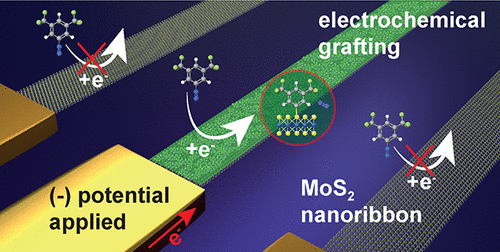当前位置:
X-MOL 学术
›
ACS Appl. Nano Mater.
›
论文详情
Our official English website, www.x-mol.net, welcomes your
feedback! (Note: you will need to create a separate account there.)
Electrochemical Functionalization of Selectively Addressed MoS2 Nanoribbons for Sensor Device Fabrication
ACS Applied Nano Materials ( IF 5.3 ) Pub Date : 2021-02-17 , DOI: 10.1021/acsanm.0c02628
Martina Lihter 1 , Michael Graf 1 , Damir Iveković 2 , Miao Zhang 1 , Tzu-Hsien Shen 3 , Yanfei Zhao 4 , Michal Macha 1 , Vasiliki Tileli 3 , Aleksandra Radenovic 1
ACS Applied Nano Materials ( IF 5.3 ) Pub Date : 2021-02-17 , DOI: 10.1021/acsanm.0c02628
Martina Lihter 1 , Michael Graf 1 , Damir Iveković 2 , Miao Zhang 1 , Tzu-Hsien Shen 3 , Yanfei Zhao 4 , Michal Macha 1 , Vasiliki Tileli 3 , Aleksandra Radenovic 1
Affiliation

|
Tailoring the surface properties of 2D materials, such as transition metal dichalcogenides (TMDCs), at the nanoscale is becoming essential in the fabrication of various 2D material-based nanoelectronic devices. Due to the chemical inertness of their basal plane, the surface modification of 2D TMDCs is limited to their defective sites, often requiring special treatments, such as the conversion of the TMDC from its semiconducting into its metallic phase. In this work, we show that the basal plane of a semiconducting 2D TMDC, molybdenum disulfide (MoS2) can be modified electrochemically by electrografting of aryl-diazonium salt. To demonstrate the advantages of this method at the nanoscale, we perform electrografting of 3,5-bis(trifluoromethyl)benzenediazonium tetrafluoroborate on predefined MoS2 nanoribbons by addressing them individually via a different electrode. The ability to selectively address individually contacted 2D layers opens the possibility for specific surface modification of neighboring 2D nanostructures by different functional groups. This method could be extended to other aryl-diazonium compounds, and other 2D semiconducting materials.
中文翻译:

选择性寻址的MoS 2纳米带的电化学功能,用于传感器设备的制造
在纳米尺度上定制诸如过渡金属二卤化物(TMDC)之类的2D材料的表面特性在制造各种基于2D材料的纳米电子器件中变得至关重要。由于其基面的化学惰性,二维TMDCs的表面修饰仅限于其缺陷部位,通常需要进行特殊处理,例如将TMDC从其半导体转换为金属相。在这项工作中,我们表明半导体2D TMDC二硫化钼(MoS 2)的基面可以通过电接枝芳基-重氮盐进行电化学修饰。为了证明该方法在纳米级的优势,我们在预定的MoS 2上进行了3,5-双(三氟甲基)苯重氮四氟硼酸的电接枝。通过不同的电极分别寻址纳米带。选择性寻址单独接触的2D层的能力为相邻的2D纳米结构通过不同的官能团进行特定的表面改性提供了可能性。该方法可以扩展到其他芳基重氮化合物和其他2D半导体材料。
更新日期:2021-02-26
中文翻译:

选择性寻址的MoS 2纳米带的电化学功能,用于传感器设备的制造
在纳米尺度上定制诸如过渡金属二卤化物(TMDC)之类的2D材料的表面特性在制造各种基于2D材料的纳米电子器件中变得至关重要。由于其基面的化学惰性,二维TMDCs的表面修饰仅限于其缺陷部位,通常需要进行特殊处理,例如将TMDC从其半导体转换为金属相。在这项工作中,我们表明半导体2D TMDC二硫化钼(MoS 2)的基面可以通过电接枝芳基-重氮盐进行电化学修饰。为了证明该方法在纳米级的优势,我们在预定的MoS 2上进行了3,5-双(三氟甲基)苯重氮四氟硼酸的电接枝。通过不同的电极分别寻址纳米带。选择性寻址单独接触的2D层的能力为相邻的2D纳米结构通过不同的官能团进行特定的表面改性提供了可能性。该方法可以扩展到其他芳基重氮化合物和其他2D半导体材料。































 京公网安备 11010802027423号
京公网安备 11010802027423号